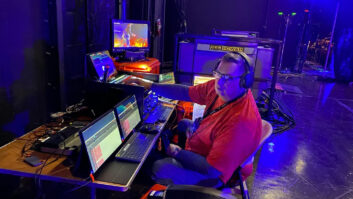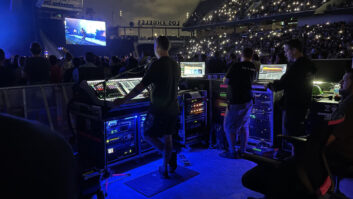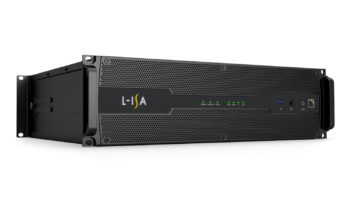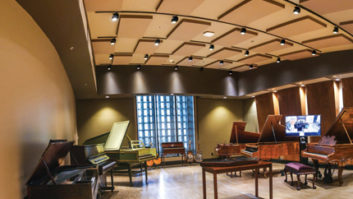An alternate headline to this article might’ve read “Old Dogs Learn New Tricks,” but calling a 24-month-old digital console “old” just didn’t feel right. Legacy mixers and brand-new releases alike made significant strides in the past year thanks to numerous operating system upgrades, new add-on options and the ever-expanding power of silicon processing chips in general. So maybe “New Dogs Join the Digital Mix Team” would be more appropriate.
Costing from under two grand to over a quarter-million dollars, one of the following digital mix consoles with live and/or recording applications is sure to grab your interest. Mix queried 35 digital console manufacturers about their new mixers and existing boards that have been significantly upgraded over the past year, and here’s what we found.
AMS Neve (www.ams-neve.com) announced the U.S. release of Logic MMC, the latest successor to the company’s classic Logic 2 digital console, at last April’s NAB show. Designed for post, music, film and DVD production, the new Logic MMC adds up to 96kHz capability, a new suite of hardware I/O options, the fourth-generation XSP DSP engine, and direct compatibility with the company’s DFC, 88R, Encore for V Series and Libra consoles automation. MIOS I/O 96 options (Modular I/O System) are accessed via a 4U rackmount hot-pluggable I/O box that connects via dual-fiber or dual-coaxial MADI to the MMC console. Five-hundred signal paths are available at 48 kHz (250 paths available at 96 kHz). Logic 1, Logic 2 and Logic 3 automation import is supported, and an automated 8-band graphic EQ option is available.
Behringer‘s (www.behringer.com) 32-channel DDX32-16 ($1,629.99) is the company’s first compact digital console, packing a lot into a small footprint. Each channel sports full parametric 4-band equalization with sweepable highpass filter. Audio can be routed through one of 16 internal buses to eight aux sends, and the board’s first 16 channels offer channel delay. Four onboard effects processors, extensive synchronization options, 17 100mm motorized ALPS faders, and two ADAT- and TDIF-ready expansion slots are included. The DDX3216 picked up a 2003 Electronic Musician Editor’s Choice Award.
Calrec (www.calrec.com), of Yorkshire, England, has been busy in the digital console arena this past year. The Alpha 100 (call for pricing) features an assignable digital control surface and up to 48 multitrack and matrix outputs and 20 aux buses. New additions include input delay, 5.1 surround joysticks, cue director and bird beater and reverse-interrogate functions. The latter two features were also added to the Sigma 100 console last year, but Calrec’s biggest news is its new Zeta 100 digital console at this month’s NAB convention. Targeted at the company’s C2 analog console user market and priced at about the same, the Zeta 100 offers powerful standard features: dynamics on every channel, 16 multitrack sends, 99 Flash ROM setup memories, and full 5.1 surround mixing and monitoring capabilities. Zeta 100, which houses all of its DSP and I/O in a single 7U rackmount space, is offered in 24, 32 and 48-fader frame sizes, and DSP allocations of up to 56 channels.
Digico‘s (www.digiconsoles.com) D5 Live digital consoles now come in two flavors: the D5 Live 56 and D5 Live 96. The same control surface and feature set adorn both consoles; the D5-56 has 64 channels of full processing, while the D5-96 provides 96 channels. The D5 Live 56 comes with one remote (stage-end) DiGi-rack containing the A/D converters and is connected to the console via optical fiber cable. A local DiGi-rack sits next to the console, offering an additional 40 external I/Os for inserts and effect sends. The D5 Live 96, with AES/EBU and MADI digital I/O, comes with two stage DiGi-racks and one local rack to provide its 96 inputs. Any D5 Live 56 can be upgraded to a 96 by adding a second remote DiGi-rack and an additional DSP card in the console. At press time, Digico was preparing to announce major upgrades to the D5 systems, including a new FOH/monitor package and the DiGiTRACS Soundcheck/Show Recorder, at the Musikmesse show in Frankfurt. See our report on page 44 for details.
The Euphonix (www.euphonix.com) System 5-M (starting at $250,000) received a Version 2.6 upgrade last fall, resulting in enhancements for music recording, mixing and post-production functions. Each of the four EQ bands per channel now covers 20 to 20k Hz (with a gain of ±24 dB), and the console’s notch filters have been updated with new algorithms for enhanced precision. Users can now include post-fader dynamics, pre/post-fader metering and post-insert delay in their console setups. Mix automation-conform enhancements with insert, move, delete, copy and other functions in System 5-M now allow complex mixes to be more easily adjusted after last-minute video edits. Other new surface enhancements include dimming of rotary controls that are not in circuit. The platform’s added features also include a new graphics display that allows operators to see EQ and filter windows simultaneously, user-definable names for MADI ports for better I/O control and an extended 48-millisecond channel path delay time. Find out about Euphonix’s new EuCon Networking technology in the “Technology Spotlight” on page 102.
Part of Fairlight’s (www.fairlightesp.com.au) DREAM family of digital audio technologies, the DREAM Console is a full-featured digital console designed to operate as a stand-alone system or as a processing hub with other DREAM components. Used with the DREAM Station, for example, the console offers fully automated mixing with an integrated 48-track disk recorder and editor, plus plug-in support. Signal control is via a central assignable panel (four can be fitted in the largest chassis size); the console delivers 96 channels of mixing into a 48-bus mix matrix, with each channel offering full 6-band EQ plus two-stage dynamics processing. The DREAM Station offers a smaller configuration of 56 full channels, mixing into a maximum of 24 mix buses. The main Station unit incorporates an assignable parameter control pad plus a single master fader, and may be expanded with 12-fader “Sidecar” fader packs. Controls and faders are identical to the console system, and all titles and projects are compatible with the console. The two systems can be networked with Fairlight’s MediaLink networking system. Both systems incorporate Fairlight’s 48-track hardware-controlled disk recorder and editor, which is also available separately as the DREAM Satellite editor. The recently released Version 2 software includes Bus Reduction (which allows the operator to create multiple simultaneous mixes for different output formats) and support for Fairlight’s Plug-Ins Manager.
A full-blooded analog board until last fall’s AES, the fully altered LPC-D from Harrison by GLW (www.harrisonconsoles.com) now sports a digital soul. A joint effort between Harrison and live sound leader Showco, the LPC-D was designed as a comprehensive solution for theater and fixed-venue sound installations. Proprietary IKIS event-based automation provides motorized VCA faders and full automation control over every setting and channel, and the same Harrison digital.engine architecture used with the company’s existing SeriesTwelve and MPC control surfaces is now incorporated into the LPC-D console. Based on 40-bit SHARC DSP chips, the third-generation digital.engine environment provides up to 768 full channels of audio per core unit, 1,344 inputs and outputs, and 176 console-wide summing buses — all controlled by a 2,240×2,240 matrix router. Every LPC-D channel contains complete dynamics processing, 4-band parametric EQ (8-band with IKIS), high- and lowpass filters, dynamics, 32 aux sends and panning facilities to support all surround formats. The LPC-D offers 96 main recording buses, 24 reassign buses (32 with IKIS) and 16 listen buses.
Developed by Digigram and distributed in the U.S. by Sennheiser (www.sennheiserusa.com), the Compact Sy40 ($32,229 base without I/O modules; $64,766 fully loaded) is a new high-performance digital mix console for live performance from InnovaSon (www.innovason.com). The Compact Sy40 sits in the same chassis and offers the same number of faders as the Compact Live console but packs more punch; as a stand-alone console, the Compact Sy40 supports 40 inputs and 16 outputs through 47 faders. But, configured with 40 input channels and 27 mix buses, the new Compact offers the ability to expand up to 72 inputs and 48 outputs if linked to the InnovaSon Stage Box. Compact Live owners can upgrade to the Compact Sy40’s new features through an upgrade kit that includes a new DSP engine and enhanced Sensoft control software.
Mackie Designs (www.mackie.com) beefed up its popular D8B ($6,995) digital console platform with updated dynamics and EQ algorithms, several new built-in production tools, an enhanced GUI and a HUI-layer-enabled way to now use the D8B as an automated control surface with I/O for a number of DAW environments. The new D8B Version 5.0 update is a major upgrade that also includes surround monitoring control and the ability to daisy-chain up to four D8B plug-ins per channel send. Users will appreciate the new EQ and dynamics views, expanded metering controls and the ability to export track sheets and channel notes as HTML files. Among other changes, most notably the improved user interface, is the addition of Mackie’s 4-band EQ, compressor/gate/expander and FatChannel tools to the D8B’s onboard processors menu. Version 5.0 is free to anyone who purchased a D8B after November 15, 2002, and is currently available as a download to all others from the Mackie Website for $299.
The Qolle izm125 Portable Digital Mixer from Tamura (www.qolle.com) was introduced at the Los Angeles AES last year. This very compact yet uncluttered 8-channel mixer was designed in partnership with top film composer/sound designer Frank Serafine, who made sure that the design addressed the needs of remote recordists and 5.1 surround sound engineers. Tamura, long-known in Japan for its analog broadcast consoles, offers users the choice between +4dBm master analog and AES/EBU, FireWire and TDIF digital I/O options. High-quality mic preamps, compressors and highpass filters are included on each of the Qolle izm125’s eight channels. A bank of RS-422/Sony 9-pin and MIDI connectors and a timecode reader/generator round out this porta-digi mixer. Tamura also released its cascadable Qolle izm806 System Controller, an advanced audio/video edit controller, and the motion JPEG Qolle izm821 Video Hard Disk Recorder/Player to complement the Qolle izm125.
Sony Pro Audio’s (www.sony.com/proaudio) DMX-R100 mixer has been enhanced with a trio of flexible new R100 expansion products. The new SIU-100 ($3,425) System Interface Card can expand the DMX-R100’s digital I/O capability to up to 72 AES/EBU, TDIF or ADAT-formatted channels, and it allows users to remotely share resources between two DMX-R100-equipped rooms. For live applications, the SIU-100 can provide 48 remote-controlled microphone inputs and eight outputs for monitors when used onstage, and also be connected at the FOH mix position with up to 300 meters of fiber-optic cable. Sony’s new DMBK-S101 8-Channel Mic Preamp Board ($2,175) offers eight balanced inputs, remote 48-volt phantom power and pad-on/off switches per channel. Rounding out the new digital console add-on offerings is the SIU-RM101 Remote-Control Unit ($2,275), a dedicated remote for the DMBK-S101 preamp that provides the same physical knobs and buttons as the DMX console. Also new is the ability to cascade two DMX-R100s with a new DMBK-R109 MADI card upgrade option ($2,500). The DMX-R100’s price has been reduced to $16,000 MSRP.
Joining its 324 Live Digital console in 2002 was Soundcraft’s (www.soundcraft.com) dual-personality music recording and post-production mixer, the Soundcraft 328XD ($5,000). This slick, compact digital console — which can also operate as a MIDI controller for a number of supported DAWs, synths and devices — accepts up to 42 inputs at mixdown and features eight groups and 16 direct outputs. Standard features include Soundcraft EQ and dynamics processing on each channel, 16 mic/line and five stereo inputs, and 16 digital inputs or tape returns via ADAT, TDIF, S/PDIF and AES/EBU formats, the latter without adding an expansion card. Dual high-resolution Lexicon effects units, 100mm motorized faders and 56-bit internal processing are also included in the 328XD, as is Soundcraft’s E-Strip technology.
The newest boards from Soundtracs (owned by Digico, www.digiconsoles.com; distributed in the U.S. by Fairlight, www.fairlightesp.com.au) are the DS-3B and D4 digital consoles for broadcast.
The DS-3B is available in either 64- or 96-channel frame sizes, with 32-bit floating-point digital processing. Each channel has four-band EQ and full dynamics capability. The worksurface, available in either 24- or 32-fader layouts, incorporates touch-screen technology in conjunction with 25 motorized faders. Operating at 96 or 48 kHz with 24-bit conversion, the console is equipped with 40 output buses, each with limiters for stereo, LCRS and 5.1 formatting. Other features include subtractive mix minus GPO, GPI and full redundant PSU’s. The DSP processing can be mounted in the console’s central leg assembly; or an external 7U 19-inch rack-mounting DSP unit can be installed up to 12 feet away from the console surface, with Digital TFT touch screens and redundant PSU on the console surface. The D4 combines Soundtracs’ touchscreen worksurface topology with a powerful digital engine, for up to 320 full audio channels and 124 output buses, all controlled by an intuitive automation system. The D4 is available in various frame sizes from a 16-fader frame up to 96 faders via optional rack expanders. Users can cascade multiple consoles for multi-operator requirements. Soundtracs is scheduled to launch the secret “DS-00” at this month’s NAB show in Las Vegas. There were few details at press time, but a representative from Soundtracs owner Digico says “the board will impact the studio market, in much the same way the [Digico] D5 has penetrated the live arena. The concept is to refocus the studio market with a console system that can be molded to meet any studios user requirement,” at a new price point.
SSL’s (www.solid-state-logic.com) MT Production (MTP) console has been known solely as a broadcast production tool, until Celine Dion sang the first note of three-year run at Caesars Palace in Las Vegas. The Colosseum, built specifically for Dion’s epic production, is where the first SSL digital console is being employed as a live sound FOH mixer. Last year, SSL released new V. 6.0 software, which drives the MTP and the company’s MT Plus consoles. Version 6 adds enhanced channel and main bus dynamics algorithms options to the MTP and MT Plus consoles, and both are now available with a selectable moving or nonmoving fader control surface. The latter improvement allows users to set a balance on a group of faders, assign those faders to a master and then close that master while still viewing the balance “under” the master fader. For late-breaking SSL console news, see the Technology Spotlight on page 100.
New V. 2.03 software is now available for Tascam’s (www.tascam.com) popular DM-24 Digital Mixer ($2,999). Over 20 enhancements include a new HUI Emulation mode, improved internal signal routing, direct surround-panning capabilities, new footswitch-control capabilities and more. The OS upgrade, available free from the Tascam Website, also allows DM-24 users to control DAW software such as Pro Tools and Digital Performer and fully control faders, pans, mutes, aux sends, track arming and transport controls with the DM-24 work surface. New 5.1 surround mixing features and direct sound-panning capabilities have been added, and a lowpass filter on the boom LFE channel now allows users to send select frequencies below the LPF point to a stem recorder. The new Center-Channel Percentage parameter regulates the center-channel input signal levels and how much of the channel’s signal is sent to the center channel of the stem recorder. New circle and square-panning patterns are driven by the data dial, allowing for continuous motion circular pans. Additional V. 2.03 features include an internal MTC generator, a post-A/D converter direct out that is ideal for live recording situations, transport lock, tape return capabilities and a pre-aux muting function.
Showing up with more than five times the processing power of its popular 02R predecessor certainly helped squelch any doubts that Yamaha’s (www.yamaha.com/proaudio) 02R96 ($11,397, includes meter bridge and wood side panels) could top its predecessor and then some. Fifty-six channels of 24-bit/96kHz audio and a range of new 32-bit internal effects are now included, including many specifically designed for surround mixing, as are other surround panning, joystick, monitoring and bass-management features. The 02R96 integrates with digital audio workstations and provides extensive support for Pro Tools. Expansion options are supported with four I/O slots that accept 24-bit/96kHz-capable Mini-YGDAI digital and analog I/O card options.
Yamaha’s DM1000 Digital Production Console ($5,000 base) delivers 48 channels of 24-bit/96kHz audio, surround production features and integrated control for DAWs and automated recording within one small 23×8×17-inch, rackmountable footprint. Integrated tools for surround processing, panning and monitoring include a mini joystick and a graphic multichannel surround pan/position display. Individual speaker mutes and attenuation and stem mix monitoring facilities are also included.
Also just announced from Yamaha at NSCA 2003 is the company’s new 01V96 ($2,499), a new digital mixer in the PM1D, 02R96, DM2000 and DM1000 lineage. An ideal mixer for small to medium permanent or mobile installations, the rackmountable 01V96 offers improved sound quality and new computer and ADAT interfaces. The 01V96 offers 40 simultaneous mixing channels at full 24/96 resolution. Inputs 1 through 32 feature fully independent gating/compression, 4-band parametric EQ, delay and two pre-EQ/post-delay insert points per channel. Stereo inputs 1 through 4 feature parametric EQ, and up to four of the built-in effect processors (two at 96 kHz) may be used simultaneously.
Last and certainly not least is the Cameo II Digital Recording Console ($12,950 start) from Zaxcom (www.zaxcom.com), though it certainly appears to be the smallest digital recording console in our roundup. The Cameo II is the company’s second-generation Cameo LRC console and is designed primarily for use as a location recorder for films, TV and other high-end audio applications, including music recording. This potent little easy-to-use, high-performance digital mixer-to-go offers upgraded mic preamps and multiframe output audio delay for use in high-definition motion picture and television production. Additional features include Deva, plasma display, wireless mic control, lots of built-in effects and GPI control in a 12×14-inch footprint.
Randy Alberts ([email protected]) has launched EveryOne Jam Project, a nonprofit music-for-peace effort to record and release improv jam discs between musicians from directly combative nations.




